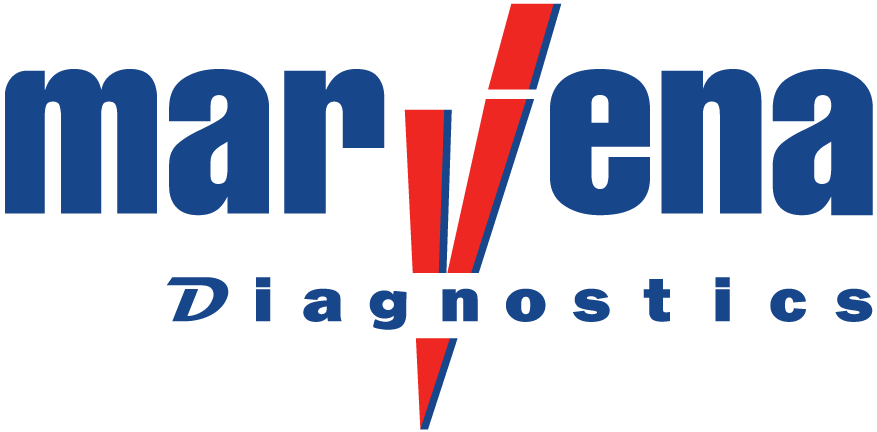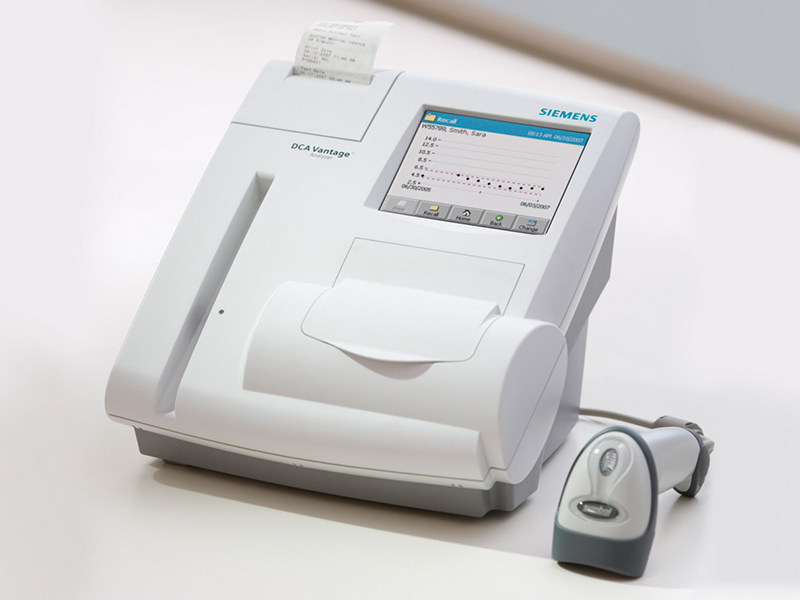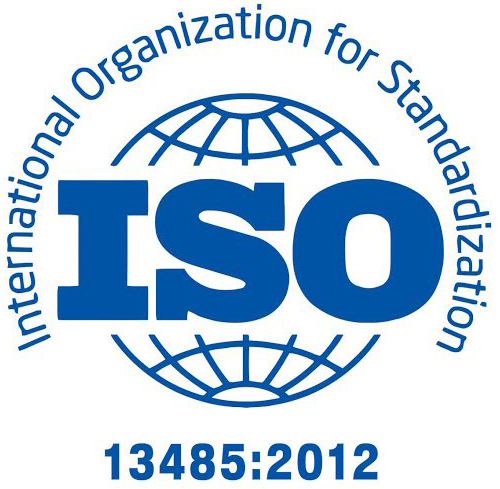Home » Products » Point Of Care » Diabetes » DCA Vantage® Analyzer
DCA Vantage® Analyzer
Drive diabetic patient compliance with trusted, clinically proven results
Provide the clinical confidence your patients deserve. The DCA Vantage® Analyzer helps you monitor glycemic control and detect early kidney disease in environments ranging from the physician’s office to remote, point-of-care coordinated sites in hospitals and multisite practices. Meet lab-quality testing standards with an analyzer that speeds and simplifies diabetes tests and delivers accurate, clinically relevant results shown to improve decision-making, patient compliance, and outcomes.
- Manage diabetes patients more effectively
- Improve workflow in office or clinic
- Simplify management of diabetes testing in decentralized settings
- One of just two HbA1c analyzers that meet NGSP performance criteria
- Used by three out of four physicians who perform HbA1c testing in their office
Monitor glycemic control and diabetes complications using an analyzer designed to make consultations easier. Fast, actionable test results enable you to determine the effectiveness of a treatment plan, make therapeutic adjustments with confidence, and be more certain whether patients are complying with your recommendations.
Monitor glycemic control
- HbA1c from a small (1 µL) whole blood sample in 6 minutes
- Flexible reporting of HbA1c% (NGSP, JDS, and Mono-S units) and IFCC (mmol/mol)
- Reporting of HbA1c results as Estimated Average Glucose values* in the same units (mg/dL) that patients’ home glucose meters display
- HbA1c patient trending graphs can be viewed or printed
Detect early kidney disease
- Albumin, Creatinine, and Albumin-to-Creatinine (A:C) ratio from a urine specimen in 7 minutes to report a quantitative protein status with automatic creatinine adjustment
- Onboard GFR calculator indexes kidney function
Improve workflow in the office or clinic
- Self-contained cartridges facilitate easy, walkaway operation after sample loading
- No sample or reagent preparation required
- Bar-code scanner for safer and faster patient/operator ID entry
- Review results on-screen or generate a hard copy report to minimize transcription errors in the office
- Convenient local storage of up to 4,000 onboard records with powerful sorting capabilities
- Automatically upload results to a PC via a USB flash drive to reduce manual logging and save time
- Minimal maintenance requirements with automatic reminders to alert you when maintenance is due
Simplify management of diabetes testing in decentralized settings
- Customizable security access modes support up to 1,000 operators, protect patient information, and prevent operation by unauthorized users
- POCT1-A2 communication protocol streamlines data transfer for easy connectivity and fast, two-way communication to LIS/HIS, RAPIDComm® System, or other third-party POC data management systems
- Automatically upload results and QC information to LIS/HIS to reduce manual logging and save time
- Take testing oversight to the next level with RAPIDComm Data Management System to remotely manage multiple analyzers and operators to enhance compliance and improve risk management. POC coordinators can standardize test procedures, enforce QC protocols, control access privileges, define operator recertification requirements, and more. Customized alerts, reports, and audit trails ensure peace of mind and simplify accreditation and inspections
Formulas for Calculated Results
% HbA1c = (HbA1c/Total Hemoglobin) x 100
eAG* mg/dL = (28.7 x HbA1C) – 46.7
eAG* mmol/L = (1.59 x HbA1C) – 2.59
GFR = 186 x (plasma creatinine mg/dL)-1.154 x (patient age years)-0.203 x (0.742 if female patient) x (1.210 if African American patient)
Formulas for Dual Reporting From IFCC to % HbA1c
NGSP = (0.09148 x IFCC) + 2.152
JDS = (0.09274 x IFCC) +1.724
Mono-S = (0.09890 x IFCC) + 0.884
Formulas for Dual Reporting From % HbA1c to IFCC mmol/mol
IFCC = (10.78 x JDS) – 18.59
IFCC = (10.11 x Mono-S) – 8.94
Overview
System Description
Point-of-care immunoassay analyzer
Quantitative Tests
Hemoglobin A1c (whole blood): Range: 2.5% to 14% (4mmol/mol to 130 mmol/mol) Microalbumin/Creatinine (urine): Single test reports all three results for: Albumin: 5 to 300 mg/L; Creatinine: 15 to 500 mg/dL (1.3 to 44.2 mmol/L); Albumin-to Creatinine Ratio: 1 to 2000 mg/g (0.11 to 226 mg/mmol)
Test Format
Self-contained immunoassay cartridges
Test Measurement
Automatic, optional transmission
Test Method
HbA1c: monoclonal antibody agglutination reaction
Albumin: polyclonal goat anti-human albumin antiserum
Creatinine: Benedict Behre chemical reaction
Time to Test Results
HbA1c – 6 minutes
A:C Ratio – 7 minutes
Test Handling
Sample Volume
HbA1c – 1µL whole blood
Microalbumin/Creatinine – 40µL urine
Sample Preparation
No pretreatment; no pipetting required
Sample ID/Operator ID Entry
Optional; via touch screen or bar code reader
Calibration
Calibration
Lot-specific calibration card provides automatic calibration with every cartridge
Traceable to International Federation of Clinical Chemistry (IFCC) reference materials and test methods for measurement of HbA1c
Onboard Computer
Storage Capacity/Memory
4000 patient and/or control records
Up to 1,000 operator IDs
Display
Color touch screen with 1/4 VGA resolution
Data Export
Via USB flash drive to PC or direct to LIS/HIS or data manager, if interfaced
Quality Control/Compliance
Flexible QC Scheduling
None, Automatic Reminders or Required
QC Testing
Optional lockout if schedule not followed or QC fails
User/Operator Access
Restricted, if desired, to protect patient and QC data and prevent unauthorized use
Matching Lab Results/Reference Method
Adjustable correlation to reference methods
Reference Ranges
User-definable reference ranges available for HbA1c
Computer/Peripheral Interfaces
Serial Port
RS232, ASTM
Ethernet Connection
ASTM or POCT1-A2
Bi-Directional Capabilities
ASTM: Remote computer can be set up to lock out patient tests
POCT1-A2: Remote computer can be set up to lock out patient tests, and send operator list to analyzer
USB-Port
Standard USB 2.0
External Bar Code Reader (optional)
Serial (9 pin)
Onboard Printer
54 mm (2 in) width, thermal/label stock
External Printer
Supports standard PCL printer interface via USB port
General
Dimensions
9.0 (h) x 11.5 (w) x 10.5 (d) inches 25.4 (h) x 28.7 (w) x 27.7 (d) cm
Weight
3.88 kg (9.0 lb)
Power Requirements
100 to 240 VAC; 50/60 Hz
Line Leakage Current
<0.3 mA in normal condition<0.5 mA in single fault condition
Maximum Power Input
70 VA; 30 watts
Ambient Operating Temperature
18°C to 30°C (64°F to 86°F) (Albumin)
15°C to 32°C (61°F to 88°F) (HbA1c)
Operating Temperature
5°C to 40°C (41°F to 104°F);
15% to 90% relative humidity
Safety
TUV SUD with CB Scheme, CSA-C22.2,
EN60601, IEC 60601, UL60601
EMC Emissions/Immunity
FCC 47: Part 15 (Class B),
EN60601-1-2 (Class B)
Why Choose Us
We believe that success is achieved with professionalism, integrity and perfect teamwork, built on the high moral values of our employees.
Our policy is based on impeccable planning, control and execution, through which we achieve maximum satisfaction of our customers.
Professional
customer service
A wide range of laboratory analyzers
Trained and experienced specialists
Certificate
ISO 13485:2012



